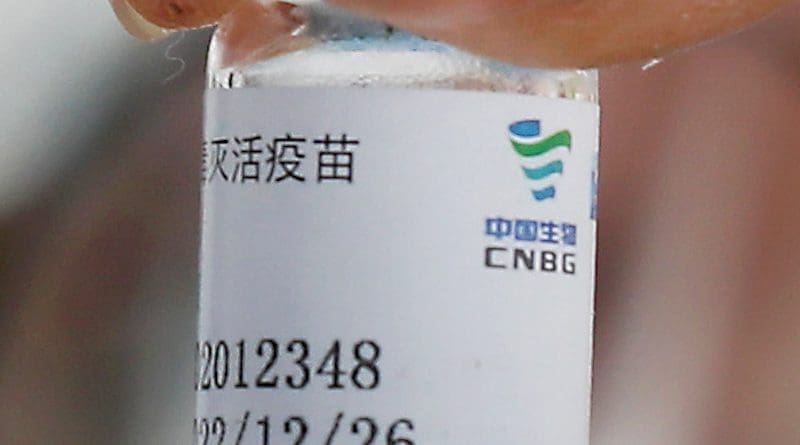Vaccine Diplomacy Leverages India To Outdo China’s Pre-Eminence In South Asia – Analysis
With COVID 19 spreading globally and the pandemic is seen far from ebbing, vaccine diplomacy has become a new dimension in India-China spat to win diplomatic and economic influences in South Asia. So far, China was using trade and investment mantle, including loaning through the Belt and Road Initiative, to exert its political and economic influences in developing and poor nations in South Asia and South East Asia. The COVID 19 shifted the power game to soft power influences. There are three biggest manufacturers of COVID 19 vaccines in the world. They are USA, China and India. While USA abstained from the soft power game by concentrating on America First, China and India pitch for a new battle for vaccine diplomacy in South Asia.
Amid the COVID 19 rattled economy, India earned an image of rising sun in new generation of global pharmaceutical industry. It is reckoned as “pharmacy of the world”. According to a survey of Coalition for Epidemic Preparedness innovations (CEPI), India, along with USA and China, are the biggest manufacturers of COVID 19 vaccine in the world. They are followed by EU, Australia, Brazil, Canada, Russia and UK.
Today, while COVID vaccine is imported by most countries in the world, few countries are exporters. According to OECD survey, vaccine is imported by 208 economies and against these they are exported by 90 economies. East Asia and South East Asia are the main sources of the vaccine. India is playing a lead role as a major source of vaccine, being both manufacturer and exporter, against the west who are restricting export as a part of the nationalization of their vaccines manufactured.
India launched “Vaccine Maitri” (Vaccine friendly) movement in early 2021. It supplied vaccine to 74 countries as well as United Nations health workers by March 2021. Burying the hatchet of commercial interest, it supplied vaccine to its poor and developing neighbours as granted on priority basis. Over 74 percent of the vaccine was distributed free to its neighbours. India did not attach any string to the free vaccine supply in these areas.
This manifests how India’s philanthropic gesture precedes to commercial interests to help its poor and developing neighbours, who succumbed to China’s debt trap under the Belt and Road initiative. India has pledged to supply 6.8 million free vaccine around the world and China committed half of this so far. “Vaccine Maitri” has raised India’s standing and generated great international goodwill, according to Foreign Minister S. Jaishankar.
None the less, the goodwill gesture was sarcastically quipped by China Foreign expert Mr Zhigun Zhu as it was India’s damage control measure to regain diplomatic power in its neighbouring countries. According to him, India was losing its stake to increasing pre-eminence of China in South Asia
Bloomberg applauded India’s vaccine empowerment over China. It said, “India beats China at its own game in vaccine diplomacy fight”. So far, China pitched an upper hand in forging ties with developing nations, including India’s neighbors, by giving loan with strings under Belt and Road Initiative. But, COVID 19 gave a diplomatic opportunity to India to become global leader. Serium Institute of India has become the main supplier. Eventually, it gears up India to scuttle China’s influence in the region.
Sri Lanka, which fell prey to the Chinese debt trap and lost Hambantota port in a deal, was upbeat with the Indian vaccination. “Because of their gift, Sri Lanka has been able to start vaccination immediately” , according to Mr Eran Wickramaratane, a Sri Lankan opposition leader.
Myanmar is another case in point to determine India’s edge over China in vaccine diplomacy. Turmoil by military coup, Myanmar was left in dark by false commitment by China, which played a predominant role in Myanmar economy and is the biggest foreign investor. Beijing pledged to supply 300,000 doses of vaccines to the Military Junta to subvert the pandemic. But, Myanmar is to receive yet any doses. In contrast India has already delivered 1.7 million doses as committed.
Bangladesh is the largest beneficiary of Indian COVID 19 vaccine. It received 9 million doses, of which 2 million were free. Myanmar received 3.7 million, of which 1.7 million was free. Nepal received 2.4 million doses, with 1.0 million free and Sri Lanka received 1.3 million doses with 0.5 million free. This reflects that that more than 70 percent of vaccines supplied to India’s neighbor were free. The entire vaccine supplied to Bhutan was free.
The next major beneficiary group is African countries, such as Nigeria, DR Congo, South Africa , Ghana, Kenya, Uganda and Ethiopia.
India’s chauvinism for “pharmacy of the world” is exemplified by its lead role in the pharmaceutical industry in the world. Indian pharmaceutical industry is the 3rd largest by volume and 11th largest in value in the world. Its annual revenue is US $ 38 billion. It comprises of 3,000 companies and 10,500 manufacturing facilities. It produces drugs at third of US cost and half of European cost, according to a Deloitte survey. India supplies 20 percent of world generics and 60 percent of its vaccines. Nearly, one-third of its exports goes to USA and about one-fifth is exported to Africa. India is the bedrock for global bio-medical research. Bangalore is a case in point.

